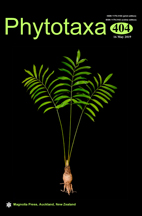Abstract
Species in Angraecum sect. Dolabrifolia (Pfitzer 1889: 216) Garay (1973: 499) were assigned to several genera until Garay (1973) finally transferred the type species, A. distichum (Lindley 1836: t. 1781), along with A. podochiloides Schlechter (1906: 162) and A. aporoides Summerhayes (1964: 560) to Angraecum Bory (1804: 359) (see Simo-Droissart et al. 2016a). Later, Angraecum bancoense Burg in Arends et al. (1980: 26) and A. poppendickianum Szlachetko & Olszewski (2001: 884) were described and included in this section. According to Garay (1973), Angraecum sect. Dolabrifolia is characterized by very short, fleshy, laterally compressed and densely imbricate leaves, with a groove on the upper surface; the lateral compression being a unique feature within the genus. Based on this unique morphological character, Szlachetko and Romowicz (2007) raised the section to the rank of genus, Dolabrifolia (Pfitz.) Szlachetko & Romowicz (2007: 54) and proposed five new combinations, namely Dolabrifolia disticha (Lindl.) Szlachetko & Romowicz (2007: 54), D. aporoides (Summerh.) Szlachetko & Romowicz (2007: 54), D. bancoensis (Burg) Szlachetko & Romowicz (2007: 54), D. podochiloides (Schltr.) Szlachetko & Romowicz (2007: 54) and D. poppendickiana (Szlach. & Olszewski) Szlachetko & Romowicz (2007: 54). The taxonomic decision of Szlachetko and Romowicz (2007) was followed by Szlachetko et al. (2013), who also raised nine other Angraecum sections to the generic rank.

